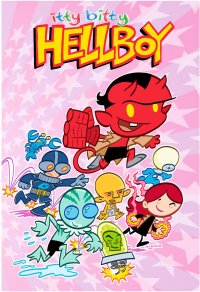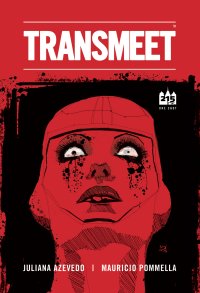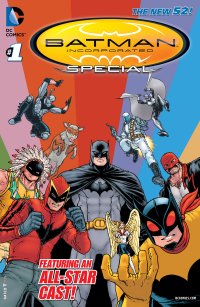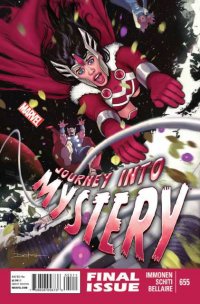Itty Bitty Hellboy #1 (of 5)(Dark Horse Comics, $2.99) 
By Graig Kent
Tiny Titans was an amazing comic for DC, both as a rare humour book and a rare younger readers title than transcended the usual patronizing of younger readers titles. It took a stable of teenage characters best known for dying horrible deaths in frequent numbers, turned them into kindergarteners, and took all the threat and malice out of their villains by making them teachers and cafeteria workers. The further creators Art Balthazar and Franco took the book’s roster into obscure territory, the more appealing it became. It was a book that could have lasted for decades, but it only lasted 50 issues (plus a 3-issue crossover with L’il Archie).
The rumblings of late about DC editorial is that they’re of the mindset that they’re not in the business of publishing comics for kids (and some could argue that they’re barely in the business of making comics for anyone, rather than just being a concept and Trademark farm) and that kids books don’t really sell well for them. I believe it’s a matter of priorities and focus. Put any sort of attention into it and I’m certain they could sell, and sell well. They just choose not to go after that market.
After Tiny Titans, Baltazar and Franco were put onto the less appealing (though still enjoyable) Superman Family, but that petered out after a year as well. The duo still works at DC as writers on the respectable title The Green Team, but it’s their younger readers material that people want out of them. A massively successful Kickstarter for their “Aw Yeah, Comics” (I’m sure DC’s kicking themselves for no copyrighting the infamous “Aw Yeah” from Tiny Titans) has definitely shown there’s a strong supporting community for what they do, and that DC’s loss will be someone else’s gain.
Enter Itty Bitty Hellboy, which effectively recycles the Tiny Titans formula of micro versions of the most famous Hellboy characters (good and bad) and puts them in a delightful backyard setting. It’s a structure Baltazar and Franco are obviously intimately familiar with and it feels like very comfortable territory for them. Though they focus more on the bad guys than good guys (tiny, kid-friendly versions of Kroenin, Rasputin and the head in a jar, Herman von Klempt should be all sorts of wrong, but these creators know exactly what they’re doing). I’m hoping that in the coming issues they flesh out the personalities of wee Hellboy, Liz, Abe and company. Roger the Homunculus as the weird kid who hangs out naked in the bushes is awesome.
The stories here are slight, but then it’s not about stories so much as it’s about hanging out with these wee versions of familiar characters. The book is unified by connective threads throughout, Karl’s obsessed with Hellboy’s big refrigerator box fortress, Roger keeps doffing his stinky underwear, and Johann has a cold, but like a chipper, more supernatural, less maudlin Peanuts, it’s really about kids aping their older selves but in far more innocent ways.
Art Baltazar’s style is becoming iconic particularly in the creation of younger-audience versions of established characters. With the Super Pets story books on top of the other projects previously mentioned all being a notable, nearly solitary presence in younger reader superhero material, it’s only a matter of time before there’s a critical mass of acceptance and appreciation of his work. You’d think Eisners would be enough, but I guess not for DC. He’s a truly unique talent worthy of Bill Watterson-level admiration, delivering a level of quality and consistency that is decepitvely simple, ceaselessly appealing and worth seeking out at every turn.
The true litmus test of this book was to see how it would play with my four-year-old daughter, and after getting past her initial wariness, she wound up giggling profusely and loving the book. She started talking about Roger and Liz and Karl as if she’d been reading them for years, and she had me repeat the characters on the cover a half dozen times over as she committed them to memory. But even if you’re not four years old, or don’t have kids, this is just pure joy in 22 pages, far better reading than most Sunday funnies, and you know if you were still buying newspapers you’d still be reading those.
[Rating 4.5]
Transmeet ($0.99 Digital, $3.99 Print, 215 Ink)
by D.S. Randlett (@dsrandlett)
Science Fiction is, as we well know by now, when operating as a metaphore for concerns of the present or emotional universals. When it doesn’t, the genre is usually just artiface to amp up an emotionally and thematically thin story. It’s what separates something like Minority Report from Paycheck. Not that I think Minority Report is one of the greats mind you, but it is worth watching and thinking about where Paycheck is just boring. It gets some of the vibe, but none of the content.
Transmeet looks promising, but by the end we’re left wondering why this story needed to be told, why it needed to be Science Fiction. As a story, it’s barely coherent: attempts are made at both relevance and resonance, but they end up falling flat at every turn. Transmeet is a love story. It’s a technothriller. It’s commentary. It’s an examination of the human condition. Unfortunately, by dint of its one shot length and the script’s lack of focus and narrative drive, Transmeet ends up failing to be any one of those things. Much less all of them at once. The central doomed romance has no room to breathe, the world has no time to develop, the central conflicts are not at all clear. Juliana Azevedo’s script, in the end, ends up being hard to finish.
Which is a shame, as the art, by Mauricio Pommela, is really great. He embraces a sort of ugliness that lets the humanity of his characters shine through. Splotches of ink get across the pollution that litters the future’s atmosphere, and his world is populated by ominous, insect-like machinery. It almost elevates the book, but the feeling that Transmeet could have been so much more with a clearer and more focused narrative hold the artist back. Still, a dollar is a good price for art this good.
Transmeet isn’t terrible, exactly, it just tries too much not hard enough. As a result there’s nothing to grab on to. Nothing to love, or hate. Like Paycheck, it’s just the trappings.
Rating: 




Out of a Possible 5 Stars
Batman Incorporated Special #1 (DC, 4.99)
By Adam X. Smith
The concept of the Batman family is a double-edged sword. On the one hand, Batman as a solitary agent with minimal human contact with anyone besides supervillains and his butler gets old pretty fast, so seeing the various Robins, Batgirls and assorted superhero flotsam that have gravitated towards his particular corner of the DCU over the years usually makes for a bit of colour and compliment in the murky grey-blue-brown world of Gotham.
The problem of course is the same with any artificial super-family created to round out a particular hero’s supporting cast – there’s an upper limit to how many hitherto unknown family members, biological or otherwise, that can be crowbarred into any story and ultimately very little to do with them other than to spin them off into solo titles or keep them around in the background filling out the scenery. No-one gives enough of a shit about Batman’s long lost uncle Crazy Keith to justify a protracted supporting appearance in the pages of Detective Comics where he sits at the breakfast table nursing a hangover whilst sexually harassing Batgirl for twenty pages. This is, after all, the flagship character of a multi-billion dollar media conglomerate we’re talking about – a child of capitalism using his time, money and dubious Jungian tendencies to beat back-alley criminals to a pulp in the name of justice. People expect Batman to be relevant, Lord only knows why, but only so long as he remains fun.
So how does Grant Morrison, self-styled “rebrand guy”, deal with a Batman franchise that has become progressively darker and a Bat-family tree that’s grown progressively tangled and thorny over the years? Does he prune it back to its basics, reconstructing the character and universe from their fundamental components as others have before him? No, he just makes it bigger and wackier. He gives Batman a son who was previously written out of continuity for the same reason Huntress hasn’t been his and Catwoman’s daughter for decades (i.e. because it immediately puts an age-bracket to the normally ageless characters and makes the joined-upness of the DC universe buggy and requiring of rebooting with increasing regularity), he kills off Batman without even pretending he’s not going to come back this time round, he inverts the relationship between Batman and Robin by replacing them with the laid-back and inoffensive Dick Grayson as Caped Crusader and shit-stain Damien as the Boy Wonder, and he takes the already ridiculous concept of the Club of Heroes – sorry, the Batmen of All Nations – no that name’s just as bad – and takes it to the logical conclusion (note the sarcasm) of turning it into a global corporate franchise. Ugh.
Well, this special gets off to a great start by virtue of the fact that Batman and Grant Morrison’s grubby fingerprints are curiously minimal, if not completely absent. As a convenient annual-sized issue, you get to see various members of Batman Inc in their element and for some of the artists and behind the scenes people of the title get a stab at telling their own stories without having to stick to the diktat of the kookiest man in Scotland and his shiny massive head.*
Standouts include regular series artist Chris Burnham’s manga and Geoff Darrow’s inspired take on Jiro Osamu, Batman of Japan, and Nathan Fairbarn and John Paul Leon’s Raven Red story “Brave” with its Mazuchelli-esque colour and linework and use of narration; I’m even willing to give the not terrible but still ridiculous El Gaucho and Knight stories a pass, in spite of the latter’s ridiculous idea of how British people talk and the former basically being a roided up version of Strongbad, due largely to the characters’ earnestness and the fact their respective stories feature Spring-Heeled Jack, pork-pie hat wearing velociraptors with laser cannons, black magic zombies and jetpacks.
But then, directly afterwards, we get a Dan Didio and Ethan Van Sciver story about Bat-Cow. Yes, you read that right – Bat-Cow. Literally, a cow, with a cape and some unusual colouring round the eyes in the shape of a bat is the hero of this story. Not Batwoman or Oracle or any of the other characters in this series that aren’t completely ridiculous. Fucking Bat-Cow. Fine, whatever. I get it, it’s a wrap-up job on a title I still don’t really care about from a writer whose work oscillates between being good and making me want to burn things. But really? Is this the damp squib this title chose to go out on? I’ve seen MAD cartoons better written than this.
For contrast, take Superman/Batman #26. This was going to be Jeph Loeb’s son Sam’s writing debut for DC Comics, but he died after struggling with cancer before he could finish it. What would have ended up being another case of what-could-have-been became a tribute issue, not only to the recently killed off Superboy but also to a much loved young man who died before he could make his mark. Twenty six of the best writers and artists, from Pat Lee through Joss Whedon and John Cassaday to Paul Levitz and Carlos Pachecho, combined to make sure that the issue not only became a fitting send off to Loeb Senior’s run but allowed what would be a throwaway story in lesser hands become a masterpiece of closed-circuit storytelling. Seriously, go find a copy of this comic and see how well you can tell a simple small-scale story with the right tools, talent and motivation behind it.
Batman Inc. Special wants to be that issue of Superman/Batman so badly it hurts, but it lacks the conviction and clarity of purpose to be anything other than an overpriced distraction. We don’t need to keep redefining Batman or snowcloning him across the world – we just need better Batman comics and more of them. This is not one of them, but it could be much worse. Seriously, it’s just that – fine, safe, boilerplate. I’m not expecting Christmas and birthday rolled into one every time I open a comic book, but at least give me something worth getting excited about.
*If my making fun of Grant Morrison’s lack of hair offends you, I suggest you read through Supergods and then you too may marvel at the level of importance he places upon it himself. The man is at times a good writer, but for the most part I find him an insufferable hippy-dippy New Age bore and a preening hipster tosspot who thinks every idea he has is fried gold. Okay. Editorialising over with.
Rating: 




Out of a Possible 5 Stars
 Journey Into Mystery #655 (Marvel, $2.99)
Journey Into Mystery #655 (Marvel, $2.99)
By Jeb D.
That bright corner of the Marvel Universe not dominated by movie tie-in franchises is dimming a bit these days. And while Peter David has been gradually winding down his long-running X-Factor series, Kathryn Immonen and artist Valerio Schiti had really just begun their rather fantastic “Journey“: a mere ten issues, with barely half of them published when the cancellation was announced. And while I’m glad that books like Hawkeye and Young Avengers seem to be thriving, it’s particularly disheartening to see reinforced yet again the notion that female characters (or writers) can’t carry their own title.
Part of the problem, I suppose, was the shift from Kieron Gillen’s tumblr-friendly Kid Loki version of Journey Into Mystery, with its intimate explorations of myth and identity, echoing the way that Neil Gaiman’s Sandman had reach and penetration outside the regular comics-reading audience. Immonen, by contrast, has been telling a good old-fashioned tale of super-powered adventure, filled with rousing fights and spectacular space-scapes; berserker rage and the wistfulness of lost love; cosmic knowledge and wry humor. Immonen doesn’t lack for thoughtfulness or characterization: the current storyline, with Sif desperately fighting her way through the forces of chaos to persuade the possessed earth-goddess Gaea not to destroy humanity in her effort to perfect it, finds plenty of time for reflection among the action beats. And Sif may lack Loki’s sly charm, but she’s an ideal protagonist for a fantasy-superhero comic: strong and resourceful, but periodically undone by her refusal to compromise. In other words, Immonen’s been writing a book, not for fans of Sandman, but for fans of Thor’s Asgardian adventures, one that you’d expect them to enjoy reading alongside Jason Aaron’s current (excellent) run; just one that happens to feature an Asgardian female at its center. And, hey, it’s not like the Big 2 never double up on favorite characters in their monthly books, so the fact that Journey Into Mystery didn’t get a Marvel Now! relaunch is particularly unfortunate.
As much as I’ve always admired Immonen’s writing, the real revelation of this book has been the art of Schiti. I can’t recall the last time I encountered an artist who was new to me, and yet seemed to have the super-heroic adventure toolkit so completely in hand. Jordie Bellaire’s coloring is perfectly suited to the task of providing visual splash, while supporting the lived-in look that Schiti brings to his visuals (when was the last time a superheroine went through an adventure with bandages all over her face?). And while the responsibilities of the cover artist grow more detached from those of the interior penciller every day, Jeff Dekal has continued to do a terrific job of capturing the spirit of high adventure and humor that has marked this series.
This final issue is as visually wide-ranging as you could ask for: opening on an amusing banter scene between a pair of astronomers, Immonen and Schiti throw us fully into Sif’s confrontation with the deranged Gaea, make a quiet space in the madness for Sif and Beta Ray Bill to recollect bittersweet days gone by, and climax with an encounter that is as thoughtful as it is apocalyptic, before wrapping up with a coda that undercuts its gentle resolution with the kind of prickly attitude that has made Immonen’s Sif such a memorable character, as our heroine runs down the list of things she’d rather do than take on the responsibilities of earth goddess (“I would rather watch Volstagg struggle to make a grocery list on a budget…“). The ending does feel unfortunately truncated, so while it provides closure to this particular storyline, it’s clear that there was promise of much more unfulfilled.
While I continue to feel that Immonen’s among the most overlooked writers working in superhero comics today, Schiti’s art here is the sort of calling card that suggests that an Avengers or X-Men assignment can’t be far off (if Marvel’s not stupid enough to let the guy get away altogether).
Rating: 




Out of a Possible 5 Stars